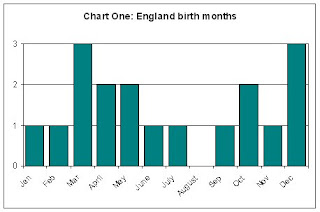Gladwell outlined one study which identified that in the highest level of Canadian ice-hockey an over-whelming number of players were born in January, February and March – well over fifty percent of some terms were born early in the year.
The reason? The cut-off date for youth levels was the 1st January, giving a year’s advantage to beef up and enhance their hand-eye co-ordination to those born earlier in the year. Once this advantage had been bedded in the early years, it reverberated into the professional leagues.
So! I wondered, what about the England cricket time? Any effect there? Here’s a chart of the birth months of the recently announced test team against the West Indies, and those still with lingering contracts.
 It doesn’t show us much, really, does it? Other than anyone being born in August is completely knackered already. Although this crumb in itself backs Gladwell’s thesis, as the cut-off date in the English junior leagues is 1st September.
It doesn’t show us much, really, does it? Other than anyone being born in August is completely knackered already. Although this crumb in itself backs Gladwell’s thesis, as the cut-off date in the English junior leagues is 1st September.Perhaps the longevity of the games levels out early differences, or the confinement of cricket to a relatively short season negates age advantages?
Generally, though, it seems as though the English selection policy at schools and villages seems to be working ok. No one is unfairly favoured by the system. Grand.
Now, lets look at the Australian cricket team:

The cut-off for Cricket Australia is also on the 1st September, but there seems to be a noticeable effect here. Indeed, more than a fifth of the entire squad were born in the month of October, with a half being born in the last quarter of the year.
So, clearly, Australia discriminates, whereas England doesn’t. According to Gladwell we would therefore expect “double” the amount of elite level cricketers in England, compared to Australia. The Pommies should crush the pommies at every meeting.
Oh dear.
Maybe discrimination at the youth level is a good idea itself, no matter which criteria you deploy to distinguish between candidates, as this allows you to focus energies on enhancing the abilities of someone who is at least reasonably good. Whereas the “let’s all have a jolly good time” approach of English cricket may not be set up to pick out and invest into those displaying talent.
That these two data sets display very different patterns, despite sharing the same cut-off date, suggests that there is something else going on here. Or maybe nothing at all. In any case, the data speaks for itself, and I need add nothing more.


3 comments:
I think the Oz birthdate graph shows that cricketers' parents celebrated New Year rather recklessly
The Australian numbers are pretty shocking in lining up almost perfectly with the cohort cutoff date hypothesis. Makes you wonder about all those poor potential Bradmans born in August who never got picked for their Jrs. But what is this . . . D.G. Bradman (b 27 August 1908)?!!! May be the cutoff date was different then, or there was no cutoff date, or hitting golf balls off of water tanks exempts you from all laws of physics.
Our chronic underachievement is entirely a product of our own actions.
Post a Comment